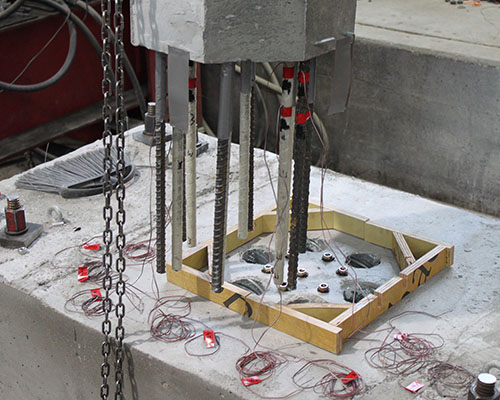

MPC Research Reports |
| Title: | Numerical Analysis of ABC Hybrid Bridge Bents Constructed with Hybrid Reinforcement |
| Authors: | Chris Pantelides, Suman Neupane, and Duc Q. Tran |
| University: | University of Utah |
| Publication Date: | Jun 2024 |
| Report #: | MPC-24-524 |
| Project #: | MPC-700 |
| TRID #: | 01930233 |
| Keywords: | accelerated bridge construction, bents, columns, earthquake resistant design, glass fiber reinforced concrete, numerical analysis, reinforcing bars, seismicity, steel |
 A numerical model simulating the seismic behavior of precast concrete columns confined with glass fiber reinforced polymer (GFRP) spirals and longitudinally reinforced with steel or a combination of steel and GFRP bars was developed using the Open System for Earthquake Engineering Simulation (OpenSees). Four column specimens were tested: two columns with steel and GFRP longitudinal bars (hybrid), and two columns with only steel longitudinal bars (all-steel). All four columns had a double layer of GFRP spiral confinement. One hybrid and one all-steel column were post-tensioned with high-strength steel bars, and carbon fiber-reinforced plastic (CFRP) jackets were applied at the column base for confinement. The columns were connected to footings using grouted duct connections and tested under cyclic loads. A computational modeling strategy is presented to analyze the column-footing connections with steel and FRP composites. The numerical model showed satisfactory agreement with experiments in terms of hysteresis curves, drift ratio at bar fracture, cumulative hysteretic energy (less than 6.0% deviation up to bar fracture), and post-tensioning force prediction (less than 5.0% difference).
A numerical model simulating the seismic behavior of precast concrete columns confined with glass fiber reinforced polymer (GFRP) spirals and longitudinally reinforced with steel or a combination of steel and GFRP bars was developed using the Open System for Earthquake Engineering Simulation (OpenSees). Four column specimens were tested: two columns with steel and GFRP longitudinal bars (hybrid), and two columns with only steel longitudinal bars (all-steel). All four columns had a double layer of GFRP spiral confinement. One hybrid and one all-steel column were post-tensioned with high-strength steel bars, and carbon fiber-reinforced plastic (CFRP) jackets were applied at the column base for confinement. The columns were connected to footings using grouted duct connections and tested under cyclic loads. A computational modeling strategy is presented to analyze the column-footing connections with steel and FRP composites. The numerical model showed satisfactory agreement with experiments in terms of hysteresis curves, drift ratio at bar fracture, cumulative hysteretic energy (less than 6.0% deviation up to bar fracture), and post-tensioning force prediction (less than 5.0% difference).
Following the successful validation of the numerical model, a similar modeling approach was used to analyze a bent of the Riverdale Bridge using actual dimensions. The aim was to compare the performance of bents reinforced with GFRP bars alongside longitudinal steel bars (hybrid) to those reinforced with steel bars only (all-steel), focusing on the system’s ability to dissipate hysteretic energy and self-center. The grouted duct connection was proven effective in resisting seismic lateral forces and bending moments between precast columns and footings in accelerated bridge construction. The hybrid system, combining GFRP bars with longitudinal steel reinforcing bars, demonstrated efficient performance in both self-centering and hysteretic energy dissipation.
Pantelides, Chris, Suman Neupane, and Duc Q. Tran. Numerical Analysis of ABC Hybrid Bridge Bents Constructed with Hybrid Reinforcement, MPC-24-524. North Dakota State University - Upper Great Plains Transportation Institute, Fargo: Mountain-Plains Consortium, 2024.